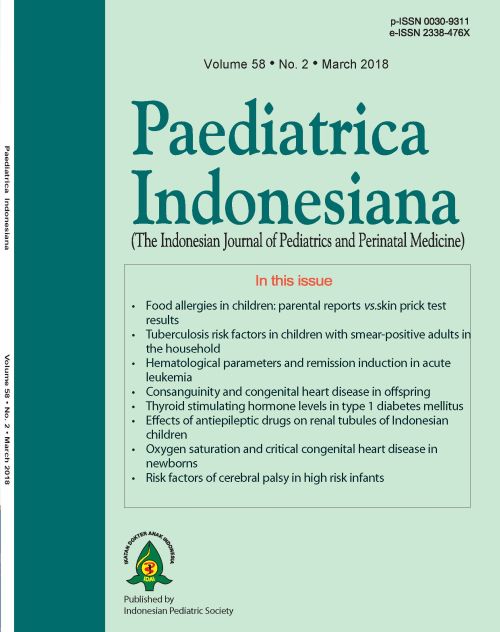Association between oxygen saturation and critical congenital heart disease in newborns
DOI:
https://doi.org/10.14238/pi58.2.2018.90-4Keywords:
oxygen saturation, critical congenital heart disease, newborn, pulse oximetryAbstract
Background Critical congenital heart disease (CCHD) is relatively common, with a prevalence of 6-8 in every 1,000 live births. This congenital anomaly is a newborn condition that would be ideally suited for a screening program, if simple and reliable methods were available. Pulse oximetry (PO) has been proposed as a screening method to detect CCHD.
Objective To assess for a possible association between decreased oxygen saturation and CCHD in newborns.
Methods We conducted a cross-sectional study from March 2014 to February 2015 in several hospitals in North Sumatra. Healthy, full term and post-term newborns aged 2 to 72 hours underwent pulse oximetry measurements on the right hand and one of the lower extremities. If oxygen saturation (SpO2) was ≤ 95%, the measurement was repeated 2 more times. Subjects also underwent echocardiography.
Results A total of 386 newborns underwent SpO2 measurements: 377 newborns had SpO2 > 95% and 9 newborns had SpO2 ≤ 95%. Of the infants with SpO2 > 95%, 297 were excluded because their parents refused echocardiography examination. Thus, 80 newborns with SpO2 > 95% and 9 newborns with SpO2 ≤ 95% underwent echocardiography. Echocardiography revealed that 5 of 9 newborns with SpO2 ≤ 95% suffered from Tetralogy of Fallot (ToF) (3 subjects) and transposition of the great arteries (TGA) (2 subjects). One infant with SpO2 > 95% had ventricular septal defect (VSD), as detected by echocardiography. Oxygen saturation ≤ 95% had significant association with CCHD (P<0.001).
Conclusion Decreased oxygen saturation has a significant association with critical congenital heart disease in newborns.
References
Clarke E, Kumar MR. Evaluation of suspected congenital heart disease in the neonatal period. Curr Paediatr. 2005;15:523-31.
Arlettaz R, Bauschatz AS, Monkhoff M, Essers B, Bauersfeld U. The contribution of pulse oximetry to the early detection of congenital heart disease in newborns. Eur J Pediatr. 2006:165:94-8.
Vaidyanathan B, Sathish G, Mohanan ST, Sundaram KR, Warrier KKR, Kumar RK. Clinical screening for congenital heart disease at birth: a prospective study in a community hospital in Kerala. Indian Pediatr. 2011;48:25-30.
Ali M. Duct-dependent congenital heart disease and their management. Kumpulan naskah lengkap PIT IKA. Medan: USU Press; 2010. p. 578-81.
Mahle WT, Newburger JW, Matherme GP, Smith FC, Hoke TR, Koppel R, et al. Role of pulse oxymetry in examining newborns for congenital heart disease: a scientific statement from the AHA and AAP. Pediatrics. 2009;124:823-36.
Riede FT, WÓ§rner C, DÓ“hnert I, MÓ§ckel A, Kostelka M, Schneider P. Effectiveness of neonatal pulse oximetry screening for detection of critical congenital heart disease in daily clinical routine-results from a prospective multicenter study. Eur J Pediatr. 2010;169:975-81.
Meberg A, Brugmann-Pieper S, Due R, Eskedal L, Fagerli I, Farstad T, et al. First day of life pulse oximetry screening to detect congenital heart defects. J Pediatr. 2008;152:761-5.
Ballard JL, Khoury JC, Wedig K, Wang L, Eilers-Walsman BL, Lipp R. New Ballard Score, expanded to include extremely premature infants. J Pediatrics. 1991;119:417-423.
Ewer KA, Middleton LJ, Furmston AT, Bhoyar A, Daniels JP, Thangaratinam S, et al. Pulse oximetry screening for congenital heart defects in newborn infants (PulseOx): a test accuracy study. Lancet. 2011;378:785-94.
Govindaswami B, Jegatheesan P, Song D. Oxygen saturation screening for critical congenital heart disease. NeoReviews. 2012;13:724-30.
Ontoseno T. Congenital heart disease, The holistic approach, now and in the future in Indonesia. Folia Medica Indonesiana. 2009;45:145-54.
Meberg A, Andreassen A, Brunvand L, Markestad T, Moster D, Nietsch L, et al. Pulse oximetry screening as a complementary strategy to detect critical congenital heart defects. Acta Paediatr. 2009;98:682-6.
Jegatheesan MD, Song D, Angeli C, Devarajan K, Govindaswami B. Oxygen saturation nomogram in newborns screened for critical congenital heart disease. Pediatrics. 2013;131:1803-10.
de-Wahl Granelli A, Wennergren M, Sandberg K, Mellander M, Bejlum C, Inganas L, et al. Impact of pulse oximetry screening on the detection of duct dependent congenital heart disease: a Swedish prospective screening studi in 39,821 newborns. BMJ. 2009;338:e3037.
Lanker AM, Chowdhary J, Jeelani N, Jeelani S, Hassan AU, Wani N. Effectiveness of pulse oximetry screening for congenital heart disease in asymptomatic new-borns. Int J Res Med Sci. 2014;2:1112-6.
Zhao MQ, Jing Ma X, ling Ge X, Fang Liu, li Yan W, Lie Wu, et al. Pulse oximetry with clinical assessment to screen for congenital heart disease in neonates in China: a prospective study. Lancet. 2014;384:747-54.
Downloads
Published
How to Cite
Issue
Section
License
Authors who publish with this journal agree to the following terms:
Authors retain copyright and grant the journal right of first publication with the work simultaneously licensed under a Creative Commons Attribution License that allows others to share the work with an acknowledgement of the work's authorship and initial publication in this journal.
Authors are able to enter into separate, additional contractual arrangements for the non-exclusive distribution of the journal's published version of the work (e.g., post it to an institutional repository or publish it in a book), with an acknowledgement of its initial publication in this journal.
Accepted 2018-04-27
Published 2018-04-27


















